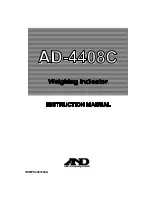
11
Introduction
Thank you, and congratulations on your choice of a Roland Classic Organ.
The Roland C-200 Classic Organs is a complete organ with 2-manual simu-
lation and numerous features in a compact cabinet.
In order to take full advantage of your C-200 and enjoy trouble-free opera-
tion, please read this owner’s manual carefully.
Please read the section “Getting Ready to Play” on p. 15 and make
the correct preparations for turning on the power.
This manual explains what you need to know to take full advantage
of the C-200, divided into a Basic Operation section and an
Advanced Operation section.
In order to present information as concisely as possible, this manual
uses the following conventions.
• Text enclosed in square brackets [ ] indicates the name of a
button (or knob); e.g., “the [8’I] piston.”
• Text preceded by a symbol such as
or an asterisk (*)
refers to warnings. Please be sure to read these.
• Text preceded by a symbol such as
refers to useful
additional information.
• Pages to which you can refer to for further information are
indicated like this: (p. **)
■
Reproduces the beautiful sound of the classic
organ, grand piano, harpsichord, fortepiano,
celesta and orchestral sounds
Grand, glorious sound is the hallmark of the classic organ. Pro-
viding a rich and spacious ensemble sound complemented by
crystal-clear definition, the C-200 will take you to new musical
heights, while sustaining the tradition of quality, craftsmanship
and innovation.
An authentic grand piano sound is included for solo and
ensemble performances. The sound-producing mechanism of
the harpsichord, the sound of the key release, and the resonance
of the sounding board have been carefully analyzed, and digital
technology is used to reproduce faithfully even the sound of the
plectrum contacting the string when a key is released. You’ll be
able to enjoy beautiful and realistic harpsichord sound.
The fortepiano, the precursor of the piano as we know it today,
produces its sounds via its strings that are struck by hammers
operated by a keyboard. The fortepiano is built entirely of
wood, the strings are struck by hammers covered in hide, pro-
ducing a metallic and brilliant sound. It enabled artists to pave
new ways and therefore explore new possibilities of expression.
There is also a Celesta sound, which is similar to a glockenspiel,
but softer and rounder. In addition, there are 12 orchestral
sounds that can be used either in isolation or together with the
organ section for a richer sound.
■
Two-manual simulation
The C-200’s 76-note keyboard can be split (divided) into two
halves to simulate an instrument equipped with manual I and
manual II.
■
Coupler II/I functionality
The C-200’s coupler function allows you to play the Manual I
sound, along with the Manual II sound on the entire keyboard.
■
Five temperaments to support historically correct
tunings
In addition to equal temperament, you can choose from Werck-
meister, Kirnberger, Vallotti, and Meantone, giving you five
temperaments that can be easily selected by pressing a single
button.
There’s also a Transpose function, which makes it easy to trans-
pose the pitch for additional ways to vary your performance.
■
No maintenance and easy pitch changes
Not only will you never need to replace the plectrums or
strings, you’ll also never need to tune this instrument.
Moreover, the C-200 is not affected by vibration or changes in
humidity or temperature. You’ll always be performing with
precisely accurate pitches guaranteed by digital technology.
It’s also easy to adjust the tuning to match other instruments.
You can furthermore use a single button to easily switch to
Baroque pitch (A= 415Hz), Versailles pitch (A= 392 Hz), Vene-
tian pitch (A= 465Hz) or the default tuning (A= 440Hz).
■
Reverb that enhances the rich acoustics of
chamber music
The built-in digital reverb lets you choose the reverberation of a
variety of environments, ranging from a small room to a large
hall. You can perform using acoustics that are appropriate for
the space you are in.
■
Adjust the volume and balance as appropriate for
your situation
Whether you’re at home, in a small hall, or in a large hall, you
can adjust the volume as appropriate for your situation or the
ensemble with whom you’re performing. You can also use
headphones, so you’ll feel free to practice at any time.
The [Balance] knob allows you to set the balance between man-
ual II and manual I + pedal.
■
Compact form that encompasses both tradition
and functionality
While reflecting the historical tradition of the classic organ, the
C-200 provides the advantage of a light weight and compact
form.
■
Five different classical sections in one instrument
The C-200 comes with five sections for various types of classical
music: “Organ” (PEDAL, MANUAL I, MANUAL II), “Harpsi-
chord”, “Fortepiano”, “Piano” and “Celesta”.
■
Optional pedal boards
Optional pedal boards are available for musicians in search of
full organ functionality.
About this owner’s manual
Conventions used in this manual
Main features
C-200_e.book Page 11 Monday, April 4, 2011 5:22 PM
Summary of Contents for Classic C-200
Page 1: ...Owner s Manual C 200_e book Page 1 Monday April 4 2011 5 22 PM...
Page 10: ...10 C 200_e book Page 10 Monday April 4 2011 5 22 PM...
Page 50: ...C 200_e book Page 50 Monday April 4 2011 5 22 PM...
Page 51: ...For EU Countries For China C 200_e book Page 51 Monday April 4 2011 5 22 PM...
Page 52: ...r 602 00 0480 02 RES 85 9 11 C 200 English C 200_e book Page 52 Monday April 4 2011 5 22 PM...












































